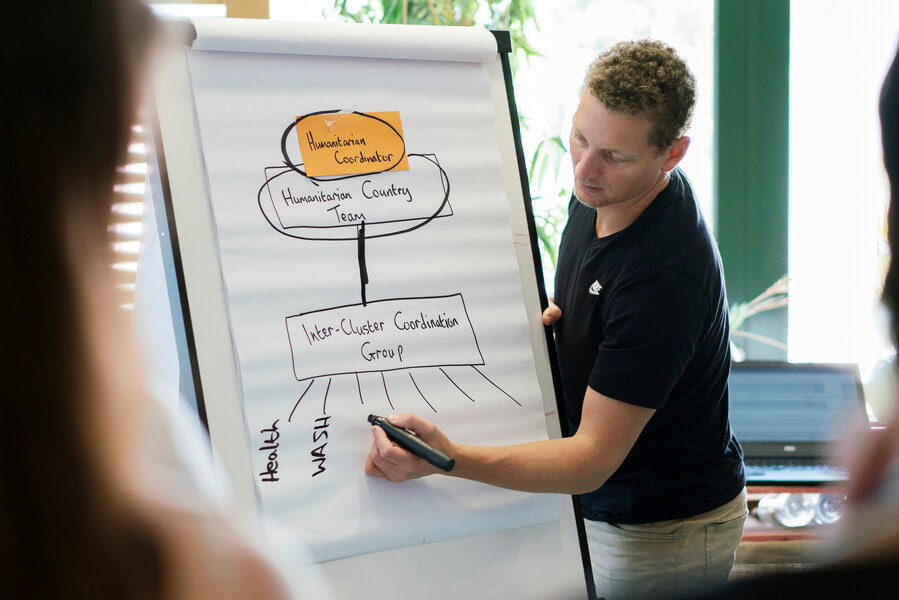
According to a recent poll I posted in our network of humanitarian training managers, these three issues are what 67% of trainers lose the most sleep over:
- Achieving consistent quality
- Reaching everyone that needs to be trained
- Finding affordable solutions
At Training In Aid, we’re focused on these problems too. 𝐖𝐞 𝐤𝐧𝐨𝐰 𝐭𝐡𝐞𝐬𝐞 𝐚𝐫𝐞 𝐭𝐡𝐞 𝐛𝐢𝐠 𝐢𝐬𝐬𝐮𝐞𝐬 𝐨𝐟 𝐨𝐮𝐫 𝐭𝐢𝐦𝐞 𝐭𝐡𝐚𝐭 𝐥𝐢𝐦𝐢𝐭 𝐡𝐨𝐰 𝐰𝐞𝐥𝐥 𝐭𝐡𝐞 𝐜𝐮𝐫𝐫𝐞𝐧𝐭 𝐠𝐞𝐧𝐞𝐫𝐚𝐭𝐢𝐨𝐧 𝐨𝐟 𝐡𝐮𝐦𝐚𝐧𝐢𝐭𝐚𝐫𝐢𝐚𝐧 𝐩𝐫𝐨𝐟𝐞𝐬𝐬𝐢𝐨𝐧𝐚𝐥𝐬 𝐚𝐫𝐞 𝐩𝐫𝐞𝐩𝐚𝐫𝐞𝐝 𝐟𝐨𝐫 𝐭𝐡𝐞 𝐧𝐞𝐱𝐭 𝐞𝐦𝐞𝐫𝐠𝐞𝐧𝐜𝐲. So, let’s reboot the dialogue and exchange a few of these ideas to help move humanitarian training beyond the basics and reach new heights.
Lets get started with the 5 hacks you wont find in any training manual to help you and your team raise the quality and consistency of your training
- 𝐇𝐚𝐯𝐞 𝐚𝐧𝐨𝐭𝐡𝐞𝐫 𝐜𝐨𝐥𝐥𝐞𝐚𝐠𝐮𝐞 𝐨𝐫 𝐝𝐞𝐩𝐚𝐫𝐭𝐦𝐞𝐧𝐭 𝐫𝐞𝐯𝐢𝐞𝐰 𝐲𝐨𝐮𝐫 𝐝𝐞𝐬𝐢𝐠𝐧 𝐝𝐞𝐜𝐢𝐬𝐢𝐨𝐧𝐬. The majority of quality issues are less to do with how a training intervention is being delivered, and more about the way it was designed in the first place. Instead of commissioning an expensive and laborious external evaluation, ask a trusted colleague who has no direct involvement in your training project to sit with you and work systematically through a sequential design tool, such as the 6Qs https://bit.ly/48MT1SO . A couple of hours with his/her fresh set of eyes and probing questions can really push you to find improvements in your training architecture, and often leads to small changes that can be implemented 𝘳𝘪𝘨𝘩𝘵 𝘢𝘸𝘢𝘺.
- 𝐓𝐚𝐤𝐞 𝐭𝐡𝐞 𝐰𝐞𝐚𝐤𝐞𝐬𝐭 𝐬𝐞𝐠𝐦𝐞𝐧𝐭 𝐨𝐟 𝐲𝐨𝐮𝐫 𝐭𝐫𝐚𝐢𝐧𝐢𝐧𝐠, 𝐭𝐡𝐞 𝐩𝐚𝐫𝐭 𝐭𝐡𝐚𝐭 “𝐡𝐚𝐬 𝐭𝐨 𝐛𝐞 𝐢𝐧𝐜𝐥𝐮𝐝𝐞𝐝 𝐛𝐮𝐭 𝐧𝐨 𝐨𝐧𝐞 𝐞𝐯𝐞𝐫 𝐞𝐧𝐣𝐨𝐲𝐬,” 𝐚𝐧𝐝 𝐭𝐮𝐫𝐧 𝐢𝐭 𝐢𝐧𝐭𝐨 𝐚𝐧 𝐨𝐩𝐞𝐫𝐚𝐭𝐢𝐨𝐧𝐚𝐥 𝐬𝐜𝐞𝐧𝐚𝐫𝐢𝐨. This technique is guaranteed to transform your participants from passive receivers of dull information into an experience they can really buy into. Your scenario can either be real, or fictional with elements taken from real events. With a little imagination, 𝘢𝘭𝘮𝘰𝘴𝘵 𝘢𝘯𝘺 𝘤𝘰𝘯𝘵𝘦𝘯𝘵 can be reworked into this method of training and instead of being seen as a weakness, this can become the part your participants end up appreciating the most.
- 𝐈𝐧𝐭𝐫𝐨𝐝𝐮𝐜𝐞 𝐚 𝐛𝐮𝐝𝐝𝐲-𝐛𝐮𝐝𝐝𝐲 𝐬𝐲𝐬𝐭𝐞𝐦 𝐢𝐧𝐭𝐨 𝐲𝐨𝐮𝐫 𝐭𝐫𝐚𝐢𝐧𝐞𝐫 𝐩𝐨𝐨𝐥. Pair up each of your senior facilitators with a junior colleague, or match two trainers together who come with markedly different perspectives. Ask them to become a first line of support for each other, then give them some basic coaching tools to analyze where they’re at and where they need to get to. You’ll be amazed how meaningful those relationships between trainers can become, and how it can motivate both team members to move to new levels.
- 𝐁𝐫𝐢𝐧𝐠 𝐲𝐨𝐮𝐫 𝐭𝐫𝐚𝐢𝐧𝐞𝐫𝐬 𝐭𝐨𝐠𝐞𝐭𝐡𝐞𝐫 𝐚 𝐝𝐚𝐲 𝐛𝐞𝐟𝐨𝐫𝐞 𝐲𝐨𝐮𝐫 𝐧𝐞𝐱𝐭 𝐭𝐫𝐚𝐢𝐧𝐢𝐧𝐠 𝐜𝐨𝐮𝐫𝐬𝐞 𝐨𝐫 𝐰𝐨𝐫𝐤𝐬𝐡𝐨𝐩 𝐚𝐧𝐝 𝐡𝐚𝐯𝐞 𝐭𝐡𝐞𝐦 𝐝𝐞𝐥𝐢𝐯𝐞𝐫 𝐩𝐫𝐚𝐜𝐭𝐢𝐜𝐞 𝐬𝐞𝐬𝐬𝐢𝐨𝐧𝐬 𝐮𝐬𝐢𝐧𝐠 𝐭𝐡𝐞 𝐦𝐚𝐭𝐞𝐫𝐢𝐚𝐥 𝐲𝐨𝐮 𝐰𝐚𝐧𝐭 𝐭𝐡𝐞𝐦 𝐭𝐨 𝐰𝐨𝐫𝐤 𝐰𝐢𝐭𝐡. You can hire in a professional training coach if you like, but it can be just as effective to use this technique as an internal teambuilding activity. The most important step is to create a safe space so that your delivery teams feel comfortable to try out new things - or try old things in a different way.
- 𝐑𝐞𝐜𝐨𝐫𝐝 𝐲𝐨𝐮𝐫 𝐨𝐰𝐧 𝐝𝐞𝐥𝐢𝐯𝐞𝐫𝐲. I’m not going to lie, if you’re anything like the 1000’s of other trainers we’ve helped over the decades, this medicine will hurt. But setting up a video recorder at the back of your next training session is the most honest feedback tool you’re ever going to get in your career. It’s a 𝘨𝘶𝘢𝘳𝘢𝘯𝘵𝘦𝘦𝘥 𝘮𝘦𝘵𝘩𝘰𝘥 to improve the quality of your training skills. Do it three times, and you’ll see a marked improvement each time. Next, delete the first two copies and send the third to your trainer pool as an example. Then, encourage them to make and share their own video recordings of sessions they felt really added value.

 RSS Feed
RSS Feed